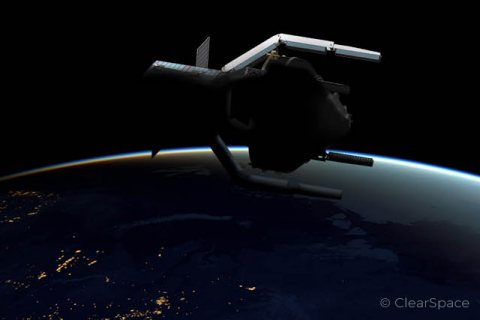Advanced technology to remove space debris from orbit
June 1, 2020According to NASA, there are more than 500,000 pieces of debris orbiting the earth. This debris is made up of spacecrafts that are no longer functional, abandoned launch vehicle stages, mission-related debris, and fragmentation debris.
“There are more than 20,000 pieces of debris larger than a softball orbiting the Earth,” says NASA. “They travel at speeds up to 17,500 mph, fast enough for a relatively small piece of orbital debris to damage a satellite or a spacecraft. There are 500,000 pieces of debris the size of a marble or larger. There are many millions of pieces of debris that are so small they can’t be tracked.”
A number of government organizations and public companies are working on projects to help reduce the very real risk of space debris damaging still-functioning equipment.
ClearSpace-1
Commissioned by the European Space Agency (ESA), ClearSpace-1 is a satellite that will find and remove non-functional satellites that are orbiting the Earth. The satellite’s first job will be to target a payload adapter called VESPA. ClearSpace-1 will use sensors to determine the location of VESPA and will launch a “chaser” to attach to VESPA. Once the chaser is attached via four robotic arms, a controlled re-entry into Earth’s atmosphere begins. The goal of re-entry is to burn up not only the target, in this case VESPA, but also the “chaser”. ESA’s goal is to have ClearSpace-1 launch in 2025.
Vestigo Aerospace
Taking a different approach to debris removal, Vestigo Aerospace has created dragsails that “greatly increases the frontal area of the system so that aerodynamic drag accelerates orbital decay.” The dragsails can be used on both functioning and non-functioning satellites as well as launch vehicle stages. The sail operates by attaching to the debris and deploying either at the end of a mission. The dragsails remove the need for propulsion-based reentry systems. Vestigo Aerospace is currently working on a six-month study of the dragsails.
Airbus Harpoon
During a successful test in 2019, a harpoon attached to the International Space Station pierced a piece of space debris and returned it to the spacecraft. Developed by Airbus, the harpoon is the size of a pen and is made from titanium. A ground control team in the United Kingdom sent both the harpoon and spacecraft a series of commands, which were run autonomously by the spacecraft. Once the harpoon pierced the debris, a “a spring-loaded mechanism deployed an array of barbs to secure the harpoon firmly in place,” reports space.com. Airbus is continuing to work on developing the technology.
Want to learn more about astronautical engineering or autonomous systems? Capitol Tech offers bachelor’s degrees in both Astronautical Engineering and Unmanned and Autonomous Systems. Contact admissions@captechu.eduto learn more.



